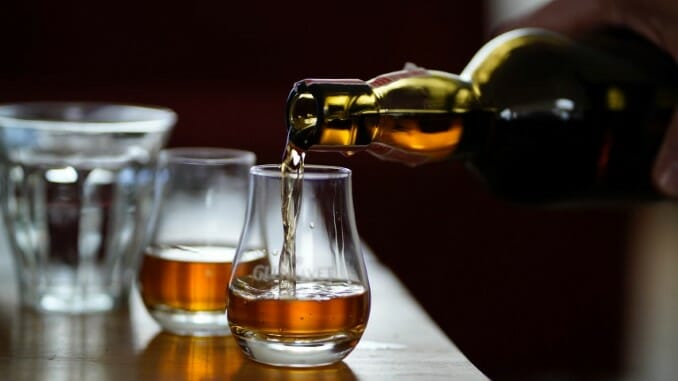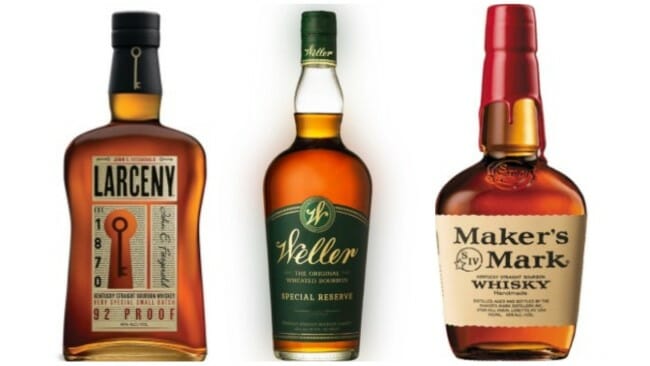What Does Bourbon Taste Like?
Photo via Unsplash, Dylan de Jonge, Josh Collesano Drink Features whiskey
This post is part of a series of informational essays for relative spirits novices, in which we’ll be discussing the flavor profiles of popular styles of distilled spirits.
What does bourbon taste like?
No, really—how does one describe the flavor profile of bourbon whiskey? When that sweet, copper liquid hits your tongue, what flavor notes should you be looking for? How do the ingredients of bourbon affect its flavor? And why does it taste the way it does?
To whiskey geeks, the answers to these elemental questions are self-evident, but to someone just exploring the world of whiskey for the first time, they’re anything but. Bourbon whiskey is a complex spirit infused with the brash spirit of the U.S.A., its country of origin. It’s the grand result of several hundred years of experimentation with the fermentation and distillation of our native crops, along with aging in another American invention: Charred oak barrels. Bourbon is a quintessentially American invention, but one that has also shaped entire industries outside of the U.S.—the scotch whisky industry as it exists today, for instance, would not be able to function without a steady supply of used American bourbon barrels.
But first things first. Say you’re a bourbon neophyte, just exploring the world of neat spirits for the first time. You know that you enjoy the flavor of bourbon, but you’re still struggling to describe how that flavor tastes to you. Well, this piece aims to give you some descriptive language to put words to what you’re tasting.
What Goes Into Determining a Bourbon’s Flavor?

It should probably not surprise you to learn that there are many, many factors that go into determining what kinds of flavors a bourbon will develop between the moment grain hits hot water, to the moment it is bottled. Some of these factors are quite technical, such as specific choices the distiller makes in the distillation process—which kinds of stills they use, how strong the spirit is coming off the still, etc. Likewise, there are important flavors being built a step earlier during fermentation, influenced by yeast strains, fermentation temperatures, and more. And of course, when it comes to bottling, a bourbon bottled at 60% ABV (120 proof) is going to taste quite a bit different and more assertive than one bottled at 40% ABV (80 proof).
For the purposes of this introduction, though, perhaps the two biggest factors contributing to a bourbon whiskey’s final flavor profile are mash bill and barrel aging.
A mash bill is the selection of grains that are chosen to make a batch of bourbon, and they vary dramatically from distillery to distillery. Some distilleries make bourbons with several different mash bills, while others (such as Old Forester, for instance) have only a single bourbon mash bill they produce. This means that every Old Forester bourbon is effectively the “same recipe,” but they’re differentiated by distillation and aging techniques, along with age and strength.
The “classic” bourbon mash bill, historically speaking, is a combination of corn, rye and malted barley—the first whiskeys we referred to as “bourbon” were made this way. Corn will always be the most prominent of the grains, as whiskeys labeled as bourbon in the U.S. must be made from at least 51% corn by law. The amount of rye, meanwhile, can fluctuate quite a bit, from less than 10% to 30% or more. Bourbons with around 20% rye or more in the grist are often referred to or marketed as “high rye” bourbons.
What of the malted barley, you may be wondering? Generally, all bourbon recipes have at least a little malted barley in them. It can contribute malty or toasty/floral flavor notes in a bourbon, but its primary function is typically to provide enzymes that help in the conversion of starches to sugars from the corn and rye in the mash bill. Just a small amount of malted barley, around 5-10% of the total mash bill, is capable of helping this step in fermentation.
In recent years, however, “wheated” bourbon mash bills have become particularly popular with consumers, and distilleries have added more wheated bourbons in an effort to take advantage of growing demand. These mash bills are exactly what they sound like, simply removing the rye portion of the grist and replacing it with wheat. Unsurprisingly, this results in a different flavor profile, which we’ll explain in more detail below. And if you’re wondering “why not both wheat and rye?,” well that is an increasingly popular choice as well. Distilleries that employ all four—corn, rye, wheat and malted barley—in a single mash bill often refer to these whiskeys as “four grain bourbons.”
After distillation, a newly created bourbon enters freshly charred white oak barrels—if a product aspires to be labeled as “straight bourbon” after at least two years of aging, it must use freshly charred barrels rather than re-using barrels that have aged spirit once or more before.
Not all barrels are created alike, however—they can vary dramatically in the level of char they’ve received, and in myriad other ways. A ”#1 char” barrel has only been exposed to the flame for a few seconds, while a #4 “alligator char” barrel has endured the firestorm for almost a full minute, becoming much more deeply charred and blistered. Distilleries choose which types of barrels to use based on which properties they’re looking to achieve—the lighter levels leave certain delicate wood flavors/compounds intact, while the more intense char provides the more intensely roasty flavors you would expect. Most distilleries use a #3 or #4 char for the majority of their products, but ranges all the way from #1 to #7 will show up in experimental releases.
 Heaven Hill released Parker’s Heritage Heavy Char Wheat in 2021, combining a wheated mashbill with an experimental #5 char level.
Heaven Hill released Parker’s Heritage Heavy Char Wheat in 2021, combining a wheated mashbill with an experimental #5 char level.
Nor is a char level the only factors that matters, when it comes to barrels. Some barrels may be toasted before charring, which will alter their flavors. Some whiskeys are finished in multiple barrel types, or transferred to a second, freshly charred barrel at the end of maturation to impart a new boost of flavor. Even the location of a barrel in the aging warehouse is of great importance, as a barrel stored up high (where heat rises) will age significantly differently from a barrel kept more cool, near the ground.
All together, these factors combine to influence a bourbon’s flavor.
How Do Common Styles of Bourbon Typically Taste?
So with all that said, how can one generally expect certain styles of bourbon to taste? Well, if the above didn’t make it clear, you can expect quite a bit of variation. However, there are certain guidelines that generally hold true.
Rye mashbill bourbons: Think of the flavor of a slice of rye bread, and how it compares to wheat bread or cornbread. Pretty dramatically different, right? Well, this is also indicative of the flavor that rye brings to the classic bourbon recipe. Rye is often described as “spicy,” and when people say this they’re implying a few things. First, rye often has a peppery quality that evokes peppercorns. But “spicy” can also refer to flavors that are reminiscent of common baking spices one would find in the cupboard, and rye can evoke these flavors: Notes such as cinnamon, anise, clove, nutmeg and ginger. Corn, meanwhile, tends to deliver sweeter core flavors, while the barrel contributes elements such as char, vanilla and caramelized sugars. Together, the classic rye bourbon thus often finds a balance between caramelized sugars, rye “spice,” herbal flavors (also from the rye), and fruitier notes.
Wheated mashbill bourbons: Whereas someone might describe rye bread as “spicy,” you’re not likely to hear someone describe wheat bread that way. The same is true of bourbons where wheat replaces rye in the mash bill—they tend to allow the inherent sweetness of the corn to shine through more, while the wheat itself contributes flavors that are toasty, creamy or “doughy.” Wheat can also have herbal or floral undertones of its own, but wheated bourbons are often described as being sweeter and presenting as “smoother” to the average palate, with the less dramatic “spiciness” simultaneously giving the bourbon a more approachable nature. It’s little wonder that wheated bourbons such as Maker’s Mark are often suggested as entry points to drinkers who are just starting to experiment with neat spirits, as the popular image is of wheated bourbon as a kinder, gentler side of the spirit.
 Larceny, W.L. Weller and Maker’s Mark are three of the most popular and common wheated bourbon brands from Heaven Hill, Buffalo Trace and Maker’s Mark, respectively.
Larceny, W.L. Weller and Maker’s Mark are three of the most popular and common wheated bourbon brands from Heaven Hill, Buffalo Trace and Maker’s Mark, respectively.
The effect of the barrel: How much the barrel affects the bourbon in your glass is a factor of time (the length of aging), barrel construction (char level, etc), and aging location (temperature, air pressure, etc.) Generally speaking, though, younger bourbons (say around 2 years) will retain more of their grain-forward flavors, and show less direct oak influence. These young bourbons are often quite sweet, with prominent corn and grain-forward flavors, and less nuance. They also often have ethanol (alcohol) character that is more overtly “boozy” and central to the flavor profile. Moderately aged bourbons (say, 4-6 years old) begin to trade in some of that overt sugariness for a more refined and well-balanced profile. Caramel, vanilla and barrel char are developed, secondary spiciness often increases, and the flavor of wood/oak takes a more central role. This exposure to oak may being to “dry out” the profile as well, balancing sweetness with tannin, bitterness or roasty astringency. Long-aged bourbons (8-12 years), meanwhile, are considered “fully mature” by most distilleries, and feature oak flavors much more strongly. There is a danger here of a bourbon becoming “overoaked,” which can result in the final product becoming unpleasantly sour, bitter, tannic or astringent, but well-aged bourbons also develop much more complex profiles of spice, herbal or earthy notes as well, such as leather or tobacco. Skilled blenders at distilleries can even find uses for barrels that would be “overoaked” on their own by blending them with less oaky bourbon, until a balanced blend is achieved.
All in all, these guidelines hold true for many bourbons, although specific distilleries have their own bourbon house styles that are also useful to familiarize yourself with. In short, truly understanding what bourbon “tastes like” is an exercise both in education and subjectivity. The more you learn about how a bourbon was made, the easier you may find it to describe its flavors. But at the end of the day, taste is purely subjective, and a matter for each person to decide for themselves—no one can tell you how your own palate works, or that you are objectively “wrong” when you say you’re picking up a specific flavor in your drink. We each get to decide for ourselves.
Now raise a glass to your own whiskey journey, as you take the next step.
Jim Vorel is a Paste staff writer and resident beer and liquor geek. You can follow him on Twitter for more drink writing.